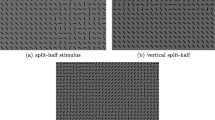Abstract
It is well-known that active selection of fixation points in humans is highly context and task dependent. It is therefore likely that successful computational processes for fixation in active vision should be so too. We are considering active fixation in the context of recognition of man-made objects characterized by their shapes. In this situation the qualitative shape and type of observed junctions play an important role. The fixations are driven by a grouping strategy, which forms sets of connected junctions separated from the surrounding at depth discontinuities. We have furthermore developed a methodology for rapid active detection and classification of junctions by selection of fixation points. The approach is based on direct computations from image data and allows integration of stereo and accommodation cues with luminance information. This work form a part of an effort to perform active recognition of generic objects, in the spirit of Malik and Biederman, but on real imagery rather than on line-drawings.
Similar content being viewed by others
References
Aloimonos, Y., Weiss, I., and Bandyopadhyay, A. 1987. Active vision. In Proc. 1st International Conference on Computer Vision, pp. 35–54.
Anderson, B.D.O. and Moore, J.B. 1979. Optimal Filtering, Information and system science. Prentice-Hall, Inc.
Bajcsy, R. 1985. Active perception vs. passive perception. In Proceedings Third IEEE Workshop on Computer Vision, Bellair. IEEE, pp. 55–59.
Bajcsy R. and Campos M. 1992. Active and exploratory perception. CVGIP: Image Understanding, 56(1):31–40.
Ballard D. 1991. Animate vision. J. of Artificial Intelligence, 48:57–86.
Bengtsson A. and Eklundh J.-O. 1991. Shape representation by multiscale contour approximation. IEEE Trans. Pattern Analysis and Machine Intell., 13:85–94.
Biederman, I. 1985. Human image understanding: Recent research and a theory. In Human and Machine Vision II, Academic Press: pp. 13–57.
Biederman I. 1987. Recognition-by-components: A theory of human image understanding. Psychological Review, 94:115–147.
Brunnström, K. 1993. Active Exploration of Static Scenes, Ph.D. thesis, Dept. of Numerical Analysis and Computing Science, Royal Institute of Technology, ISRN KTH/NA/P-93/295E.
Brunnström K., Eklundh J.-O., and Lindeberg T. 1990. On scale and resolution in active analysis of local image structure. Image and Vision Computing, 8:289–296.
Brunnström, K., Lindeberg, T., and Eklundh, J.-O. 1992. Active detection and classification of junctions by foveation with a headeye system guided by the scale-space primal sketch. In G. Sandini (ed.), Proc. 2nd European Conference on Computer Vision, volume 588 of Lecture Notes in Computer Science, Springer-Verlag. (Santa Margherita Ligure, Italy), pp. 701–709.
Crowley, J. and Christensen, H. (eds.) 1995. Vision-as-Process, Basic Research on Computer Vision Systems. Basic Research Series. Springer-Verlag.
Culhane, S. and Tsotsos, J. 1992. An attentional prototype for early vision. In Proc. 2nd European Conference on Computer Vision, Santa Margherita Ligure, Italy, pp. 551–562.
Dickinson S.J., Pentland A.P., and Rosenfeld A. 1992a. 3-d shape recovery using distributed aspect matching. IEEE Trans. Pattern Analysis and Machine Intell., 14(2): 174–198.
Dickinson S.J., Pentland A.P., and Rosenfeld A. 1992b. From volumes to views: An approach to 3-d object recognition. Computer Vision, Graphics, and Image Processing: Image Understanding, Special Issue on CAD-Based Vision, 55(2):130–154.
Dreschler L. and Nagel H.-H. 1982. Volumetric model and 3d-trajectory of a moving car derived from monocular tv-frame sequences of a street scene. Computer Graphics and Image Processing, 20(3):199–228.
Fischler M. and Bolles R. 1981. Random sample consensus: A paradigm for model fitting with applications to image analysis and automated cartography. Commun. ACM, 24:381–395.
Förstner, W. and Gülch, E. 1987. Detection and precise location of distinct points, corners and centres of circular features. In Proc. Intercommission Workshop of the Int. Soc. for Photogrammetry and Remote Sensing, Interlaken, Switzerland.
Kitchen L. and Rosenfeld R. 1982. Gray-level corner detection. Pattern Recognition Letters, 1(2):95–102.
Koenderink J. and van Doorn A. 1990. Receptive field families. Biological Cybernetics, 63:291–375.
Lindeberg T. 1993. Detecting salient blob-like image structures and their scales with a scale-space primal sketch: A method for focus-of-attention. International Journal of Computer Vision, 11(3):283–318.
Lindeberg, T. 1994. Scale-Space Theory in Computer Vision. The Kluwer International Series in Engineering and Computer Science. Kluwer Academic Publishers.
Malik J. 1987. Interpreting line drawings of curved objects. International Journal of Computer Vision, 1(1):73–104.
Moravec, H.P. 1977. Obstacle avoidance and navigation in the real world by a seeing robot rover. Stanford AIM-340.
Pahlavan, K. 1993. Active Robot Vision and Primary Ocular Processes. Ph.D. thesis, Dept. of Numerical Analysis and Computing Science, Royal Institute of Technology, ISRN KTH/NA/P-93/165E.
Pahlavan, K., Uhlin, T., and Eklundh, J.-O. 1992. Integrating primary ocular processes. In Proc. 2nd European Conference on Computer Vision, Santa Margherita Ligure, Italy, pp. 526–541.
Rimey, R. and Brown, C. 1992. Where to look next using a bayes net: Incorporating geometric relations. In Proc. 2nd European Conference on Computer Vision, Santa Margherita Ligure, Italy, pp. 542–550.
Tenenbaum, J.M. 1970. Accomodation in Computer Vision. Ph.D. thesis, Stanford University.
Ullman S. 1987. Visual routines. In W. Richards and S. Ullman (eds.), Image Understanding 1985–86. AbIex, Norwood, N.J.
Waltz D. 1975. Understanding line drawings of scenes with shadows. In W. P.H. (ed.), The Psychology of Computer Vision, McGraw-Hill, New York.
Westelius, C.-J., Knutsson, H., and Granlund, G.H. 1991. Focus of attention control. In Proceedings of the 7th Scandinavian Conf. on Image Analysis, Aalborg, Denmark, pp. 667–674.
Wilkes, D. and Tsotsos, J.K. 1992. Active object recognition. In Proceedings 1992 IEEE Comp. Soc. Conf. on Computer Vision and Pattern Recognition, Champaign, IL, pp. 136–141.
Wilkes, D. and Tsotsos, J.K. 1993a. Behaviours for active object recognition. In Proceedings 1993 SPIE, Boston, MA, pp. 225–239.
Wilkes, D. and Tsotsos, J.K. 1993b. Efficient serial associative memory. In Proceedings 1993 IEEE Comp. Soc. Conf. on Computer Vision and Pattern Recognition, New York, NY, pp. 701–702.
Zhang, W. and Bergholm, F. 1993. An extension of Marr's signature based edge classification and other methods for determination of diffuseness and height of edges, as well as line width. In H.-H.N., et. al. (ed.), Proc. 4th International Conference on Computer Vision, Berlin, Germany, pp. 183–191.
Author information
Authors and Affiliations
Rights and permissions
About this article
Cite this article
Brunnström, K., Eklundh, JO. & Uhlin, T. Active fixation for scene exploration. Int J Comput Vision 17, 137–162 (1996). https://doi.org/10.1007/BF00058749
Issue Date:
DOI: https://doi.org/10.1007/BF00058749




